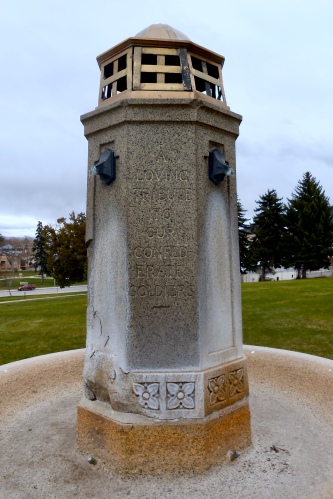
As the state of Montana chokes on forest fires, the hottest local controversy in Helena is the removal of the Confederate Memorial Fountain from Hill Park.
Initially, I was in a position similar to many Helenans; I disagreed with the racist past that such a monument represented, but acknowledged that Helena was settled by Civil War survivors from both the north and south; our local geography runs from Unionville to Confederate Gulch. The debate felt like a tempest in a teapot.
But then, I took another look at the issue, and realized that the intent of the fountain was not really about beautifying the city or creating a memorial to fallen soldiers. It originally was part of a larger, nationwide attempt to rewrite history. The same is true of many confederate monuments throughout the United States. Few were placed after the Civil War itself, most went up much later. Innocuous-sounding dedication statements of 1916 notwithstanding, monuments put up throughout the Jim Crow era of roughly 1890-1920 had support for blatant racism at their core. Pieces such as the Helena fountain were a dog whistle of sorts, promoting the “lost cause” of the south, promoting white supremacy with gracious words and curlicues carved into granite.
It is important to revive an accurate historic narrative to put these monuments into their proper place, whether that place is a museum or a trash heap.
Erected in 1916 and the only monument to the Confederacy in the Northwestern United States, the Helena fountain faced often-indifferent maintenance and few people paid much attention to it. But the timeline could not be more clear: In 1915, a silent film originally titled “The Klansman” opened and became a runaway blockbuster in its time. Released as Birth of a Nation1, the film led to increased popularity and membership for the Ku Klux Klan by its portrayal of the “lost cause” of the Southern Confederacy. The film was used as a propaganda tool for decades. The shift in white attitudes nationwide was dramatic.
Locally, the thriving African-American population of Helena, about 400 in 1906, dropped to a small handful of people by the late 1920s. Though poor economic conditions are traditionally blamed, there is little doubt that racism took its toll. It is not mere coincidence that the fountain, and surrounding propaganda of the “lost cause” of the south, normalized what was once called a rebellion.
Initial efforts to remove the fountain came in 2015 after the racially-motivated church shootings in Charleston, South Carolina. A compromise of sorts was reached for the fountain to be kept, but adding interpretative signage to explain its history and intent. The language for a sign was drafted, but then progress stopped.2
Fast forward to the 2017 rallies in Charlottesville, Virginia where white supremacists of various ilk protested the removal of a statue of Robert E. Lee, and a young woman was killed. The Helena city commission expressed concern that the Helena fountain could become a local rallying point for similar trouble. They were further motivated in part by a request from a number of state legislators, and declared enough was enough. The fountain was removed from the park.
Immediately a cry of protest went up that the fountain’s removal was “erasing history”. 1916 news reports were unearthed, discussing the good intentions and great expense that went into its creation. People wrapped themselves in the Confederate battle flag and two protestors were arrested. Opinion in Helena remained split. Was this overkill?
The City Commissioners did act abruptly. Few believed the fountain was really about to become the site of a KKK rally. They also did a poor job of making a clear case to the public about the larger movement that this statuary represented. But awkwardness notwithstanding, they made the right decision. History is not being erased, merely refocused.
There’s a clear line between statuary that commemorates history and that which rewrites history. In the case of public art, there is a false equivalency between monuments to things we honor in US History and specific monuments to the Confederacy, which was a rebellion fomented by people whose rhetoric about state’s rights and personal freedom was code language for a desire to preserve and perpetuate slavery. A Confederate memorial might have a place in a southern graveyard or a Montana museum, but not in a city park. It is time to remove these monuments that were created to promote “alternative facts.”
I further reject the slippery slope reasoning of those who claim that memorials to founding fathers who also happened to be slave owners, such as Jefferson or Washington, are going to be next. Nonsense. Proper historic analysis asks that those we study are looked at honestly, warts and all. Jefferson was a slave owner, yes, and there is no reason to whitewash it. But Jefferson also drafted the Declaration of Independence.3 The mistakes people made are not of all who they are—they did great things in spite of their weaknesses. I used to tell students in my history classes, “our heroes sometimes had feet of clay, but they accomplished some amazing things anyway, so what’s our excuse?”
The fountain, or at least the parts containing its worn inscriptions should be preserved somewhere, in a manner to not “erase” history, but help future generations learn it in a proper context.
- A long and complicated tale of wordy phrasing and ADA compliance issues seems to have been the source of the delay, along with a fair degree of foot-dragging.
- Not to be confused with the very different 2016 film of the same title.
- Yes, the “Committee of Five” charged with drafting was John Adams, Benjamin Franklin, Thomas Jefferson, Robert Livingston, and Roger Sherman.
